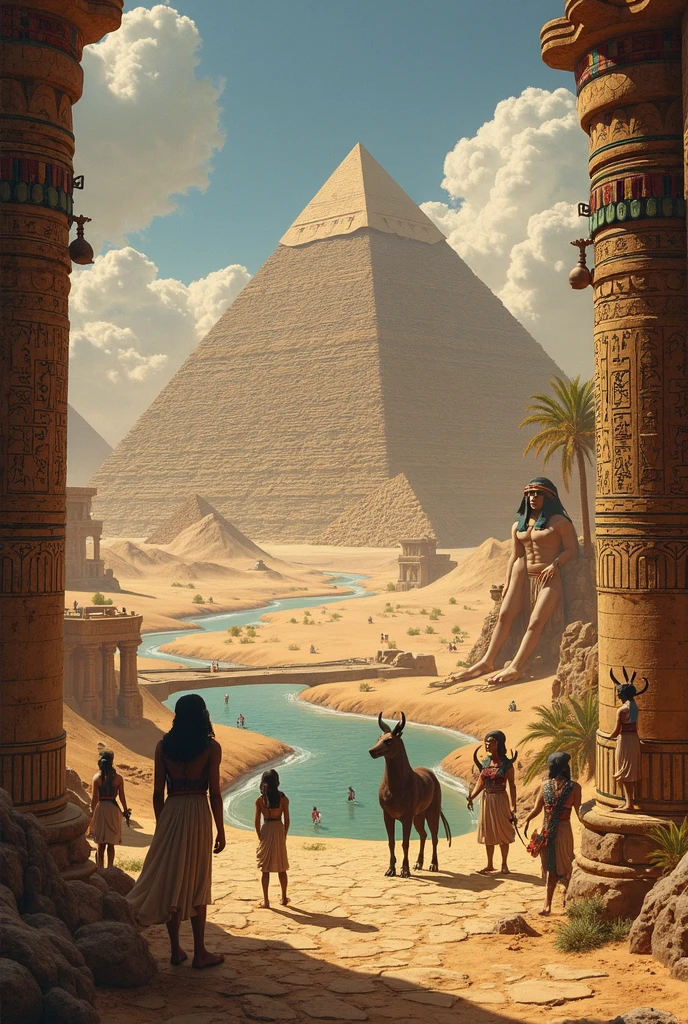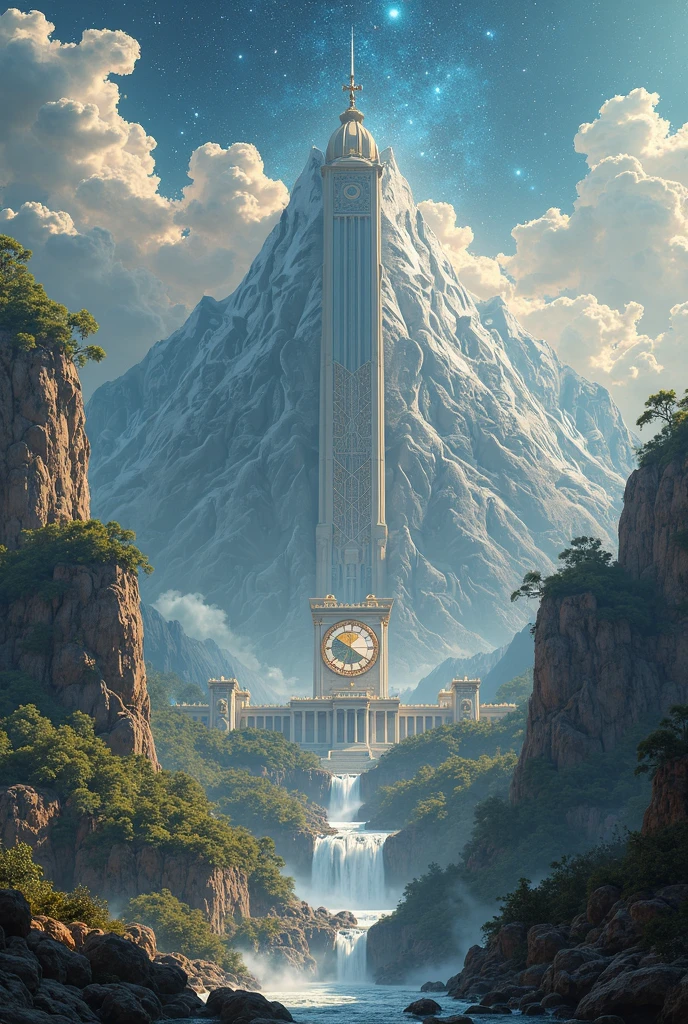Basque Mythology: The Enigmatic World of Mari and the Sorginak
The rich tapestry of Basque mythology is filled with fascinating deities, spirits, and legends that have shaped the cultural identity of Euskadi for centuries. At the heart of these myths stands Mari, the supreme goddess of the Basque pantheon, whose influence extends over nature, weather, and justice. Alongside her, beings like the Sorginak (witches), Akerbeltz (the black goat), and the mysterious Lamia populate a world where caves and mountains serve as gateways to the supernatural.
Mari: The Queen of Basque Mythology
Mari is the central figure in Basque mythology, often depicted as a powerful and capricious goddess who dwells in the depths of caves and atop sacred mountains. She is associated with natural phenomena such as storms, lightning, and the fertility of the land. Unlike many other mythological figures, Mari is neither entirely good nor evil—she rewards those who respect her and punishes those who defy her.
Key Attributes of Mari
- Dual Nature: Mari embodies both creation and destruction, reflecting the balance of nature.
- Sacred Dwellings: She resides in caves, such as the famous Anboto Cave, which is considered her primary home.
- Shape-shifting: Mari can transform into various animals, including a white horse, a red bull, or an eagle.
- Justice: She punishes liars and oath-breakers, often by sending storms or plagues.
The Sorginak: Witches of Basque Lore
The Sorginak are the witches of Basque mythology, often linked to Mari as her servants or adversaries. These figures play a complex role in folklore, sometimes acting as healers and other times as malevolent beings who curse livestock and people.
Roles of the Sorginak
| Role | Description |
|---|---|
| Healers | Some Sorginak were known to use herbs and rituals to cure illnesses. |
| Midwives | They assisted in childbirth, blending magic with practical knowledge. |
| Accursed | Others were feared for their ability to bring misfortune. |
Akerbeltz: The Black Goat and Guardian
Another intriguing figure in Basque mythology is Akerbeltz, the black goat often associated with witchcraft and protection. Farmers would keep a black goat in their stables, believing that Akerbeltz would safeguard their livestock from evil spirits.
Symbolism of Akerbeltz
- Protector: Seen as a guardian against curses and diseases.
- Witchcraft: Linked to nocturnal gatherings of the Sorginak.
- Duality: Represents both fertility and the underworld.
The Mysterious Lamia: Water Spirits of Basque Mythology
The Lamia are supernatural beings resembling mermaids or nymphs, often found near rivers and springs. They are known for their beauty and their ability to lure humans into their watery domains.
Characteristics of the Lamia
| Trait | Description |
|---|---|
| Appearance | Human upper body, often with bird or fish-like lower half. |
| Behavior | Can be benevolent or dangerous, depending on the tale. |
| Habitat | Freshwater sources like rivers, wells, and springs. |
Sacred Caves in Basque Mythology
Caves hold a special place in Basque mythology, serving as entrances to the underworld and the dwelling places of deities like Mari. Many of these caves are still visited today for their spiritual significance.
Notable Mythological Caves
- Anboto Cave: Mari’s primary residence, located in the Anboto Mountain.
- Zugarramurdi Cave: Infamous for its association with witch gatherings.
- Ekain Cave: Known for its prehistoric art and spiritual importance.
For further reading on Basque mythology, check out these resources: Buber’s Basque Mythology, Euskoguide, and Ancient Origins.
Explore more fascinating articles on our website and follow us on facebook.com/zatiandrops for daily updates on mythology and folklore!
Among the most enigmatic figures in Basque mythology are the Jentilak, a race of giants believed to have inhabited the Basque Country before the arrival of Christianity. These colossal beings were said to possess immense strength and were often associated with the construction of megalithic structures like dolmens and stone circles. Legends describe them as both fearsome warriors and wise teachers who introduced agriculture and metalworking to humans.
Characteristics of the Jentilak
- Physical Appearance: Towering figures with long beards and primitive clothing made of animal hides.
- Superhuman Abilities: Capable of hurling massive boulders across valleys, shaping the Basque landscape.
- Cultural Contributions: Credited with teaching humans how to cultivate crops and forge tools.
The Legend of the Last Jentil
One of the most famous tales involves the last surviving Jentil, Olentzero, who foresaw the birth of Christ and converted to Christianity before disappearing. In modern Basque tradition, Olentzero has evolved into a Christmas figure who delivers gifts to children, blending pagan and Christian influences.
The Basajaun: Wild Men of the Forest
Closely related to the Jentilak are the Basajaun (meaning “Lord of the Forest”), hairy, humanoid creatures who dwell in the deep woods. Unlike their giant cousins, the Basajaun are protectors of wildlife and shepherds, often warning flocks of approaching storms or wolves with loud whistles.
Basajaun in Folklore
| Aspect | Description |
|---|---|
| Appearance | Tall, covered in hair, with a muscular build and glowing eyes. |
| Behavior | Generally benevolent but can be territorial if provoked. |
| Symbolism | Represents the untamed power of nature and ancestral knowledge. |
Dragons and serpentine beings also feature prominently in Basque mythology, with the Herensuge (seven-headed dragon) and the Erensuge (a lesser serpent) embodying chaos and destruction. These creatures often guard treasures or kidnap maidens, requiring heroes to confront them in epic battles.
The Herensuge’s Role in Myths
The Herensuge is frequently depicted as a foe of Mari, symbolizing the struggle between order and chaos. In some stories, the goddess transforms into a lightning bolt to strike down the beast, reinforcing her dominion over natural forces.
Notable Dragon Tales
- The Dragon of Aralar: A Herensuge slain by the knight Teodosio de Goñi, a legend tied to the Sanctuary of San Miguel de Aralar.
- The Serpent of Itxina: An Erensuge said to dwell in the limestone caves of the Itxina Massif, guarding hidden gold.
Many Basque traditions still echo ancient myths, with festivals blending pagan and Christian elements. These celebrations often honor deities like Mari or commemorate battles against mythological beasts.
The Akelarre: Witch Gatherings
The term Akelarre (meaning “goat’s meadow”) refers to nocturnal gatherings where the Sorginak allegedly convened to worship Akerbeltz and practice magic. Historical records from the Spanish Inquisition exaggerated these rituals, but modern scholars suggest they may have been remnants of pre-Christian fertility rites.
Elements of an Akelarre
| Component | Purpose |
|---|---|
| Circular Dance | To invoke spiritual energy and commune with deities. |
| Herbal Brews | Used for healing or divination, often containing hallucinogenic plants. |
| Animal Sacrifice | Rare but documented in some accounts as offerings to Akerbeltz. |
The Carnival of Lantz: A Battle Against Evil
In the village of Lantz, an annual carnival reenacts the capture of Miel Otxin, a bandit linked to mythological villains. The festivities include masked dancers and a mock trial, symbolizing humanity’s triumph over chaos—a theme rooted in older myths about defeating giants or dragons.
From literature to cinema, Basque mythology continues to inspire artists and storytellers. Contemporary works often reinterpret figures like Mari or the Jentilak, blending ancient lore with modern themes.
Mythology in Basque Literature
Authors like Bernardo Atxaga and Joseba Sarrionandia have woven mythological motifs into their novels, exploring identity and cultural memory. Atxaga’s Obabakoak, for instance, includes tales reminiscent of Sorginak legends.
Modern Adaptations
- Film: The 2010 movie Black Bread incorporates Basque myths as metaphors for post-war trauma.
- Music: Folk groups like Oskorri use traditional instruments to recreate mythical soundscapes.
- Visual Arts: Sculptor Jorge Oteiza drew inspiration from Jentilak for his abstract works.
Mythological Tourism in Euskadi
Tourists flock to sites like the Cave of Zugarramurdi or the Anboto Mountain to experience the landscapes that shaped these legends. Local guides often narrate myths during hikes, deepening visitors’ connection to the region’s heritage.
Top Mythological Sites to Visit
| Location | Mythological Significance |
|---|---|
| Monte Urkiola | Sacred mountain linked to Mari and the Basajaun. |
| Dolmen of Sorginetxe | Known as the “House of Witches,” tied to Sorginak rituals. |
| Leizearen Cave | Legendary dwelling of a Lamia who lured fishermen. |
For further reading on Basque mythology, check out these resources: Buber’s Basque Mythology, Euskoguide, and Ancient Origins.
Explore more fascinating articles on our website and follow us on facebook.com/zatiandrops for daily updates on mythology and folklore!
The Eguzkilore: The Sunflower of Protection
In Basque mythology, the Eguzkilore (meaning “sun flower”) is a dried thistle or sunflower-like plant believed to ward off evil spirits, witches, and storms. Hung on doors or windows, it symbolizes the power of the sun and serves as a protective talisman. This tradition reflects the deep connection between nature and spirituality in Basque culture.
Symbolism and Uses of the Eguzkilore
- Protection: Placed at entrances to homes to repel Sorginak and malevolent beings.
- Solar Connection: Represents the life-giving power of the sun, akin to Mari’s control over natural forces.
- Ritual Significance: Used in ceremonies to bless livestock or newly built houses.
The Gaueko: The Night-Dweller
Another lesser-known but chilling figure is Gaueko, a demonic entity associated with darkness and the dangers of the night. Gaueko is said to punish those who wander outside after sunset, embodying the fear of the unknown that lurks beyond the safety of hearth and home.
Characteristics of Gaueko
| Trait | Description |
|---|---|
| Appearance | Often described as a shadowy figure with glowing eyes or a monstrous, shapeless form. |
| Behavior | Preys on travelers, livestock, or children who defy nighttime warnings. |
| Countermeasures | Lighting fires or carrying an Eguzkilore was believed to deter Gaueko. |
The Tartalo: The Basque Cyclops
Similar to the Greek Cyclops, the Tartalo is a one-eyed giant who dwells in caves and devours humans. These creatures appear in cautionary tales, often defeated by clever heroes who exploit their single eye’s vulnerability.
Famous Tartalo Stories
- The Shepherd’s Triumph: A young shepherd blinds a Tartalo with a red-hot iron rod, echoing the Odysseus-Polyphemus myth.
- The Tartalo of Ataun: A local legend about a giant defeated by villagers using teamwork and wit.
Mythological Creatures in Basque Heraldry
Many Basque coats of arms and symbols feature mythological creatures, reinforcing their cultural importance. For example, the Lauburu (Basque cross) is sometimes linked to solar worship, while dragons and lamias appear in regional emblems.
Symbols and Their Meanings
| Symbol | Mythological Connection |
|---|---|
| Lauburu | Represents the sun’s movement, possibly tied to Mari’s celestial aspects. |
| Dragons | Symbolize strength and the struggle against chaos, as seen in Herensuge legends. |
| Oak Trees | Sacred to the Basajaun and Jentilak, embodying endurance and wisdom. |
The Influence of Basque Mythology on Language
The Basque language, Euskara, preserves mythological references in idioms and proverbs. Phrases like “Mari has taken him” (meaning someone vanished mysteriously) or “Akerbeltz’s luck” (referring to unexpected fortune) reveal how deeply these myths are woven into daily speech.
Common Mythological Expressions
- “Sorgin baten begirada” (A witch’s gaze): Describes a malevolent glare.
- “Lamiaren hitza” (A Lamia’s word): Refers to a deceptive promise.
- “Jentilen indarra” (A Jentil’s strength): Praises someone’s physical power.
Rituals and Offerings to Mari
To appease Mari, ancient Basques performed rituals involving offerings of food, coins, or handmade objects. These were left at caves, springs, or crossroads—liminal spaces believed to bridge the human and divine realms.
Traditional Offerings
| Offering | Purpose |
|---|---|
| Bread and Honey | To ensure a bountiful harvest or livestock fertility. |
| Silver Coins | Left at springs to seek Mari’s favor in legal disputes. |
| Wax Figures | Used in healing rituals, shaped like afflicted body parts. |
The Basques and the Afterlife
Unlike many European mythologies, Basque folklore lacks a detailed underworld concept. Spirits of the dead were thought to linger near their homes or burial sites, sometimes appearing as ghosts or Orion (a spectral hunt). Caves like Zugarramurdi were believed to be gateways for souls.
Beliefs About Death
- Ancestor Veneration: Families honored deceased relatives with meals left at gravesites.
- Herioaren Atea (Door of Death): A mythical portal where souls departed, guarded by Mari or Basajaun.
- Nocturnal Spirits: The Galtzagorriak, mischievous imps, were said to escort the dead.
For further reading on Basque mythology, check out these resources: Buber’s Basque Mythology, Euskoguide, and Ancient Origins.
Explore more fascinating articles on our website and follow us on facebook.com/zatiandrops for daily updates on mythology and folklore!
The Galtzagorriak: Mischievous Imps of Basque Folklore
Among the most playful yet troublesome creatures in Basque mythology are the Galtzagorriak, small red-clad imps known for their trickery and speed. These diminutive beings would assist witches or perform household chores in exchange for food, but were equally likely to cause chaos if displeased.
Traits of the Galtzagorriak
| Characteristic | Description |
|---|---|
| Appearance | Knee-high humanoids wearing red caps and pointed shoes |
| Behavior | Swift workers by day, pranksters by night |
| Weakness | Could be controlled through specific chants or offerings of milk |
The Mairu: Builders of Megaliths
Often confused with the Jentilak, the Mairu were another race of giants credited with constructing the mysterious stone monuments dotting the Basque countryside. Unlike their more benevolent cousins, the Mairu were said to be melancholic beings who mourned the disappearance of their kind.
Mairu Legends
- Stone-Throwing Contests: Competed with each other by tossing massive rocks across valleys
- Funerary Practices: Believed to bury their dead in dolmens with elaborate rituals
- Christian Persecution: Many legends tell of their disappearance with the arrival of Christianity
Weather Magic in Basque Tradition
The control of weather elements was a crucial aspect of Basque mythology, with various rituals developed to influence rain, storms, and sunshine. These practices often involved interactions with Mari or her lesser-known counterpart Odei, the personification of storm clouds.
Traditional Weather Rituals
| Ritual | Purpose | Method |
|---|---|---|
| Stone Washing | To bring rain | Throwing specially selected stones into sacred springs |
| Cloud Herding | To clear storms | Symbolic sweeping motions with branches toward the mountains |
| Fire Lighting | To stop hail | Kindling fires at crossroads during storms |
The Basandere: Lady of the Woods
A lesser-known but important figure is the Basandere, the female counterpart to the Basajaun. Described as a beautiful, wild woman with flowing hair covered in leaves, she protected forest animals and punished hunters who took more than they needed.
Encounters with Basandere
- Guardian of Game: Controlled the population of deer and boars in the forests
- Test of Worthiness: Would challenge hunters to riddles or physical tests before allowing them to hunt
- Herbal Knowledge: Taught the use of medicinal plants to worthy humans
Mythological Creatures in Basque Children’s Games
Many traditional Basque children’s games incorporate mythological creatures, serving both as entertainment and as subtle ways to pass down folklore through generations.
Popular Mythological Games
| Game | Mythological Element | Description |
|---|---|---|
| Sorgin Jokoa | Witches (Sorginak) | Tag variation where “witches” chase other children |
| Mariren Etxea | Mari’s dwelling | Hide-and-seek played around a designated “cave” |
| Herensugearen Ehiza | Dragon hunt | Team game mimicking dragon-slaying adventures |
The Influence of Roman Mythology
While Basque mythology maintained its distinct character, some Roman influences can be detected in later versions of the myths, particularly in the northern regions where Roman presence was stronger.
Roman-Basque Syncretism
- Lunar Deities: The Basque moon goddess Ilargi acquired some attributes of Roman Luna
- Cave Sanctuaries: Roman worship of nymphs in springs merged with local Lamia beliefs
- Festival Dates: Some pagan Basque celebrations shifted to coincide with Roman calendar events
The Role of Blacksmiths in Basque Myths
Blacksmiths held a special place in Basque mythology, often portrayed as possessing semi-magical knowledge passed down from the Jentilak. Their forges were considered liminal spaces where the mundane and magical worlds intersected.
Smithing Legends
| Legend | Description | Mythological Connection |
|---|---|---|
| The First Axe | A smith learns metalworking from a Basajaun in exchange for bread | Explains human acquisition of technology |
| Mari’s Horseshoes | A smith must shoe Mari’s lightning-fast steed without looking | Test of skill and courage |
| The Cursed Anvil | An anvil that rings by itself foretells deaths in the village | Connection to the spirit world |
For further reading on Basque mythology, check out these resources: Buber’s Basque Mythology, Euskoguide, and Ancient Origins.
Explore more fascinating articles on our website and follow us on facebook.com/zatiandrops for daily updates on mythology and folklore!


